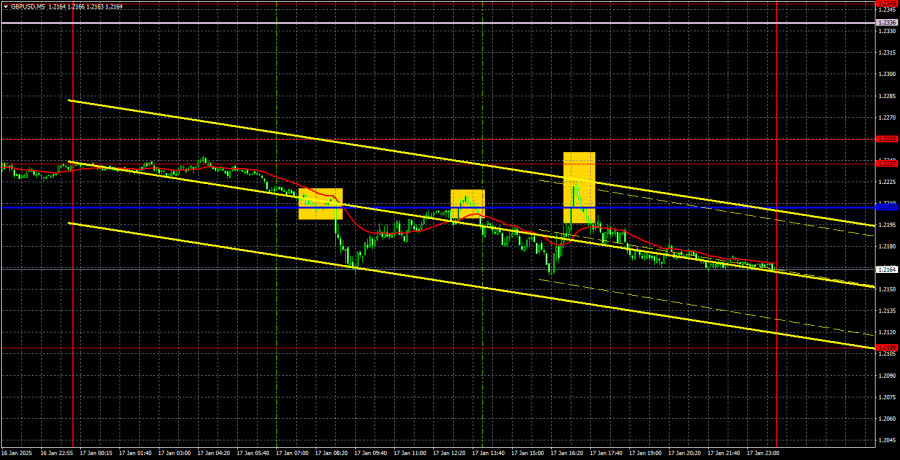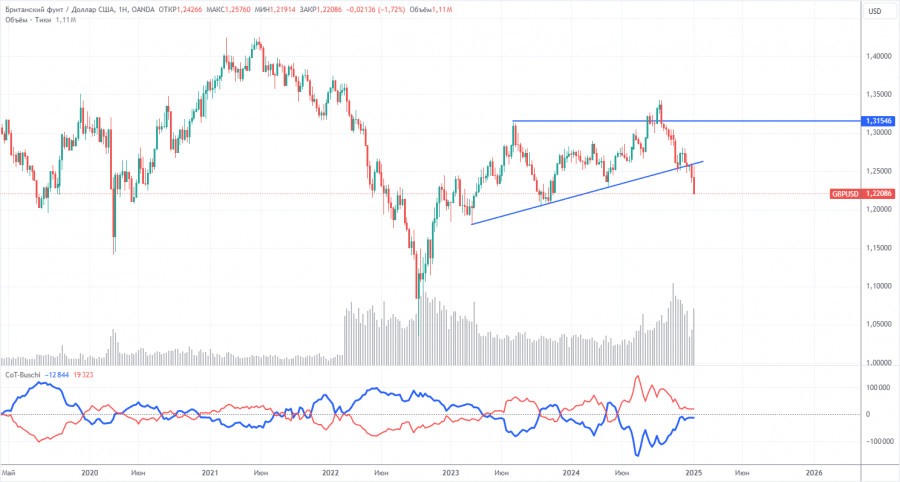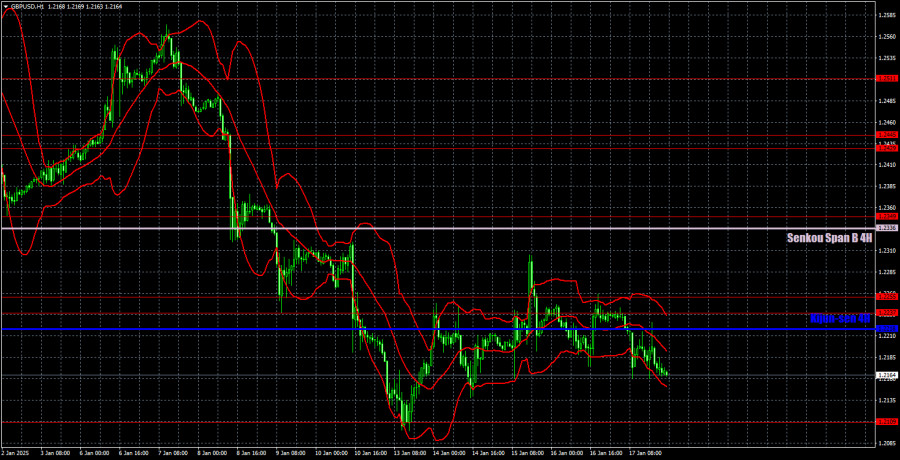Vea también


 20.01.2025 03:56 AM
20.01.2025 03:56 AMThe GBP/USD currency pair continued its downward trend on Friday. While a weak upward correction was observed on the hourly timeframe, the British pound is gradually sliding towards its lowest point in the past 14 to 15 months. Typically, when a trend ends, we see a sharp rebound from the lows, indicating a rapid closing of short positions. This suggests that investors and traders no longer believe in further movement. Currently, however, there is no sign of such a rebound, indicating that the decline may persist, with a target of 1.1800— a level we discussed extensively last year. With each passing day, the likelihood of reaching this target increases.
It's important to note that hitting 1.1800 might not signify the end of the pound's decline. The pound has been depreciating for 16 years, and there are still no indications that this global trend is about to change. From a macro perspective, the GBP/USD pair experienced a two-year correction and may now enter another year of decline. Logically, targets are set below the previous low of 1.0354. Fundamental factors support this trend: recent inflation reports from both the UK and the U.S. have favored the dollar, while overall macroeconomic data from the UK has been disappointing, in contrast to strong U.S. data. Therefore, we anticipate that the pair could at least return to the 1.2109 level in the near future.
On Friday, the price bounced three times from the 1.2207–1.2237 range, with 1.2207 representing the Kijun-sen line. These three signals essentially mirrored each other, preventing traders from making significant profits. However, the pound's decline may continue calmly on Monday.
The Commitments of Traders (COT) reports for the British pound indicate that the sentiment among commercial traders has been fluctuating over recent years. The red and blue lines in the reports represent the net positions of commercial and non-commercial traders, and they frequently cross each other, often hovering near the zero mark. Currently, these lines are close together, suggesting a roughly equal number of buy and sell positions.
On the weekly timeframe, the price initially broke below 1.3154 and then dropped to the trendline, which it also broke. This break of the trendline suggests a high probability that the pound's decline will continue, raising concerns from a long-term perspective.
According to the latest COT report for the British pound, the non-commercial group opened 1,600 buy contracts and 100 sell contracts, resulting in a net position increase of 1,500 contracts. However, this does not bode well for the pound.
The current fundamental analysis provides no justification for long-term purchases of the British pound, which remains at risk of resuming its global downtrend. As a result, the net position may continue to decline, indicating reduced demand for the pound.
On the hourly timeframe, the GBP/USD pair generally shows a bearish outlook, with recent corrective movements ending as swiftly as previous ones. Currently, there are no fundamental reasons supporting a rise in the British pound, except for the technical necessity of occasional corrections. This pattern appears consistently week after week—weak corrections followed by strong declines. In the medium term, we continue to anticipate a movement towards $1.1800.
For January 20, the following key levels are highlighted: 1.2052, 1.2109, 1.2237–1.2255, 1.2349, 1.2429–1.2445, 1.2511, 1.2605–1.2620, 1.2691–1.2701, and 1.2796–1.2816. The Senko Span B line (1.2336) and the Kijun-sen line (1.2218) may also provide useful signals. A Stop Loss is recommended to be set at breakeven once the price moves 20 pips in the correct direction. It is important to keep in mind that the lines of the Ichimoku indicator can shift throughout the day, which should be factored in when determining trading signals.
For Monday, there are no scheduled macroeconomic releases in either the UK or the US. The only event that could influence currency pair movements is the inauguration of Donald Trump. The potential impact on the markets remains uncertain, but it is suggested that the dollar may strengthen once again. At the very least, the prevailing technical picture indicates further declines for both the pound and the euro.
You have already liked this post today
*El análisis de mercado publicado aquí tiene la finalidad de incrementar su conocimiento, más no darle instrucciones para realizar una operación.
Ayer se formaron varios puntos de entrada al mercado. Veamos el gráfico de 5 minutos y analicemos lo que ocurrió. En mi pronóstico matutino presté atención al nivel de 1.2842
Ayer se formaron varios puntos de entrada al mercado. Veamos el gráfico de 5 minutos y analicemos lo que ocurrió. En mi pronóstico matutino presté atención al nivel de 1.1086
Ayer se formaron varios puntos de entrada al mercado. Veamos el gráfico de 5 minutos y analicemos lo que ocurrió. En mi pronóstico matutino presté atención al nivel de 1.2754
Ayer se formaron varios puntos de entrada al mercado. Veamos el gráfico de 5 minutos y analicemos lo que ocurrió. En mi pronóstico matutino presté atención al nivel 1.0987
Ayer se formaron varios puntos de entrada en el mercado. Echemos un vistazo al gráfico de 5 minutos y veamos qué ocurrió allí. En mi pronóstico de la mañana presté
Ayer se formaron varios puntos de entrada en el mercado. Echemos un vistazo al gráfico de 5 minutos y veamos qué ocurrió allí. En mi previsión de la mañana, presté
Ayer se formaron varios puntos de entrada en el mercado. Echemos un vistazo al gráfico de 5 minutos y veamos qué sucedió allí. En mi pronóstico de la mañana presté
EUR/USD: plan para la sesión europea del 19 de marzo. Informes COT Commitment of Traders (análisis de las operaciones de ayer). El euro se compra cada
Ayer sólo se formó un punto de entrada. Echemos un vistazo al gráfico de 5 minutos y veamos qué ocurrió. En mi pronóstico de la mañana, presté atención al nivel
Ayer sólo se formó un punto de entrada adecuado. Propongo echar un vistazo al gráfico de 5 minutos y entender lo que ocurrió. En mi pronóstico de la mañana presté
Club InstaForex

Your IP address shows that you are currently located in the USA. If you are a resident of the United States, you are prohibited from using the services of InstaFintech Group including online trading, online transfers, deposit/withdrawal of funds, etc.
If you think you are seeing this message by mistake and your location is not the US, kindly proceed to the website. Otherwise, you must leave the website in order to comply with government restrictions.
Why does your IP address show your location as the USA?
Please confirm whether you are a US resident or not by clicking the relevant button below. If you choose the wrong option, being a US resident, you will not be able to open an account with InstaTrade anyway.
We are sorry for any inconvenience caused by this message.



